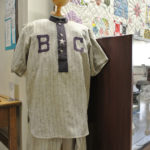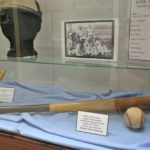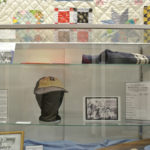Base ball in Richmond: 1910 Style
by Joy Lewis –
 One day last fall a donation came into the Historian’s office that was quite intriguing: Mrs. Helen Launt came by and brought an undated photograph of ten men. On the back was written “Allen’s Hill base ball team The Mountain Climbers” and the names of the men. I wanted to know more.
One day last fall a donation came into the Historian’s office that was quite intriguing: Mrs. Helen Launt came by and brought an undated photograph of ten men. On the back was written “Allen’s Hill base ball team The Mountain Climbers” and the names of the men. I wanted to know more.
Consulting the Federal Censuses for the years 1900, 1910, and 1920 I discovered the ages of the baseball players. With information gleaned from files on hand as well as material collected from old newspapers, it could be deduced that the photo was taken around 1910. I also learned much about “base ball” as it was played locally at the turn of the twentieth century.
Richmond had two teams: one has been mentioned and the other was the Honeoye team, which was formed in May 1889 and continued in existence until the mid-1920s (and perhaps longer). Eldridge’s downtown store advertised in the Livonia Gazette on April 29, 1897 that it was “the place to go for base ball goods.” A baseball cost a dollar, the bat a little bit more, and a glove still more.
Upcoming games and reports of games played were regular features on the pages of hometown newspapers. A game in Waterloo in the spring of 1894 was  played between “the lean men and the fat.” Amateur leagues were formed locally. One in which the Richmond teams probably participated was the Genesee Valley Base Ball League. Another was the Livingston County Base Ball Association, organized early in 1900 by Mason Egbert and Fred Woolett. Three years later the first World Series was played by professional teams.
played between “the lean men and the fat.” Amateur leagues were formed locally. One in which the Richmond teams probably participated was the Genesee Valley Base Ball League. Another was the Livingston County Base Ball Association, organized early in 1900 by Mason Egbert and Fred Woolett. Three years later the first World Series was played by professional teams.
For the next three decades local amateur base ball was all the rage, with teams forming in most Livingston and Ontario County communities. The Livonia Gazette of June 2, 1911, noted that “it is certain now that the base ball fever is contagious.” An anonymous poem printed in the Hemlock High School Gazette of April 7, 1922, sums up the spirit of the times.
I’d rather do English than swim.
I’d rather do French than skate,
For that ne’er fills me with vim.
And base ball I’ve given the gate.
I’m really a geometry fan,
For base ball I don’t give a slam.
Homework’s my joy;
So, I’m happy – O boy!
What a wonderful liar I am!
 Most amateur teams were known simply by the town or village they represented, but other teams chose colorful monikers for themselves: “The Empires” (Shortsville), “The West River Team” (Middlesex), “Monarchs,” “Brownies,” “Hustlers,” and “Bisons” (all from Conesus), “Clovers” and “Cardinals” (two of the several Rochester teams), and “Giants” (Cuba). The fanciful nicknames added color to the reportage of games. “The Monarchs mowed down the Wayland boys at Wayland by a score of eleven to two” in the summer of 1911.
Most amateur teams were known simply by the town or village they represented, but other teams chose colorful monikers for themselves: “The Empires” (Shortsville), “The West River Team” (Middlesex), “Monarchs,” “Brownies,” “Hustlers,” and “Bisons” (all from Conesus), “Clovers” and “Cardinals” (two of the several Rochester teams), and “Giants” (Cuba). The fanciful nicknames added color to the reportage of games. “The Monarchs mowed down the Wayland boys at Wayland by a score of eleven to two” in the summer of 1911.
Local contests given newspaper space included a game played May 30, 1902: “The Honeoye base ball team played the Bristols and defeated them thirteen to seven Decoration Day.” Hemlock was a traditional rival of the Richmond teams, as reported of a game in August 1909: “Last week Thursday the Hemlock boys came here [to Honeoye] and played a game of base ball with our boys. No scores were made until the last inning, when the Hemlock team made five and Honeoye two.” The following summer, the tables were turned: “A ball game between Hemlock and the Mountain Climbers resulted in a defeat for Hemlock by the score of four to three.”
Base ball began to “catch on” in America after the Civil War. Through four decades of play, the rules and regulations were tweaked and fiddled with until by 1910 the game had (nearly) evolved to its present-day stage. In the 1880s the men played with a bat that was rounded on one side and flat on the other. By 1910 the rules stipulated that the bat must be made of wood, rounded, 2¾ inches in diameter, and up to 42 inches long. Nineteenth century baseballs were individually made by wrapping a soft core in wool fiber and covering that with two leather halves stitched together around the middle. The baseball of 1910 was made of a rubber core, tightly wrapped with yarn and encased in a horsehide cover shaped in two figure-eight pieces which were sewn on tightly. This regulation ball weighed five ounces and was nine inches in diameter.
Procedures of play which are now familiar were in place by the first decade of the twentieth century: after four balls, the batter could take his base; the game was played in nine innings, with the highest scoring team the winner; the game was governed by an umpire; large padded mitts were permitted the catcher; the batter must touch each base when running; “called strikes” were at the judgment of the ump; the close of the season came in September.
The photograph of the 1910 Mountain Climbers piqued my interest in the men as well as in the game as it was played locally. The story would not be complete without remembering the lives of those who were featured in that photo. A future article will give details of each player: Raymond C. Francis, John J. Meehan, John Deal, Wales Duffy, Ray Ogden, Albert C. Belcher, Peter Cook, Otis Simpson, Lafayette Johnson, and Fred Decker.
The story of Richmond’s baseball teams seemed one worth an exhibit. As it turned out, however, the Honeoye-Richmond Historical Society had no artifacts pertaining to baseball. But the Bristol Historical Society had a substantial collection of memorabilia. Beth Thomas, the Bristol historian, was kind enough to lend our museum several items, which are now on display in the museum in the back room of the Richmond Town Hall (partial case shown above).
Author’s note: baseball was spelled as two words, base ball 1910 style.